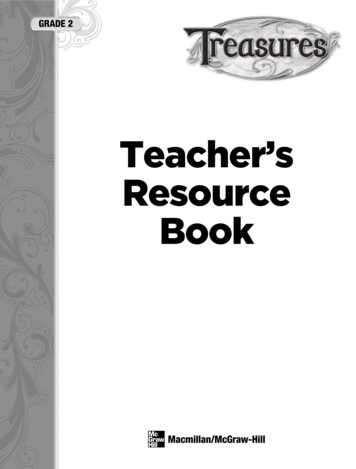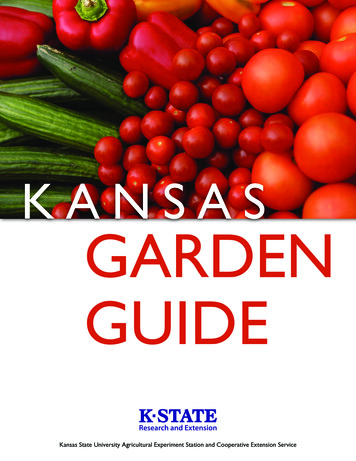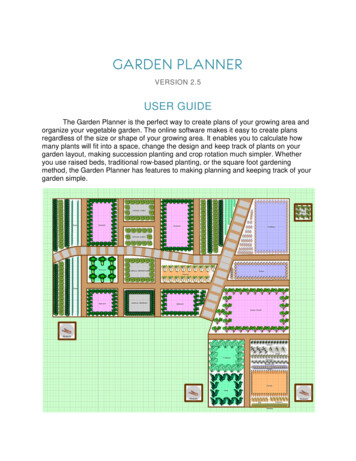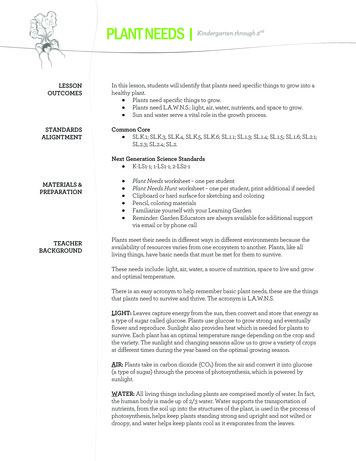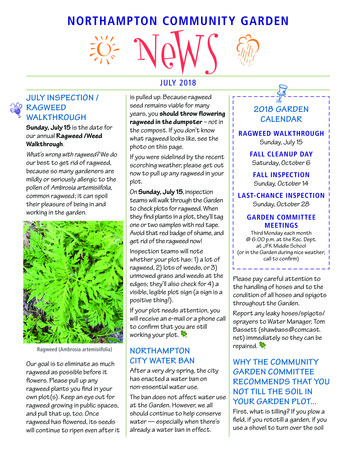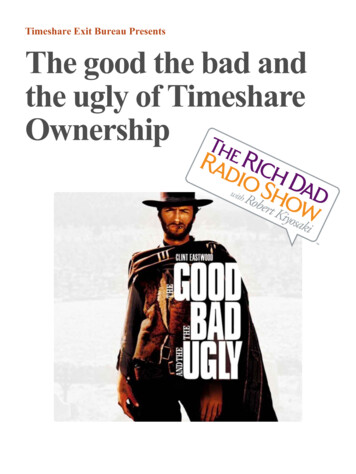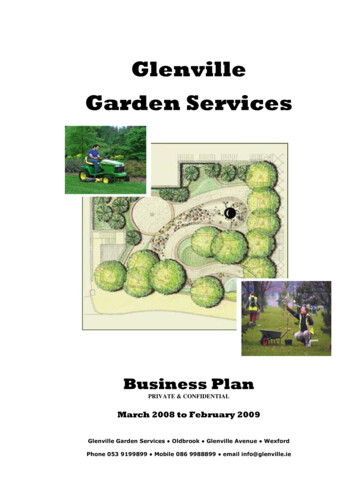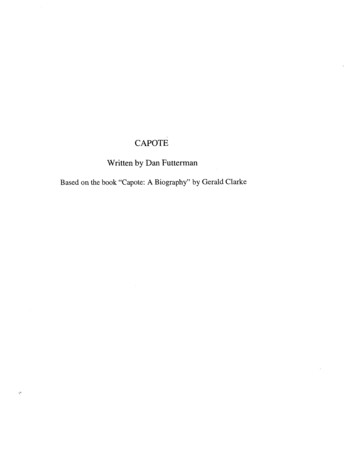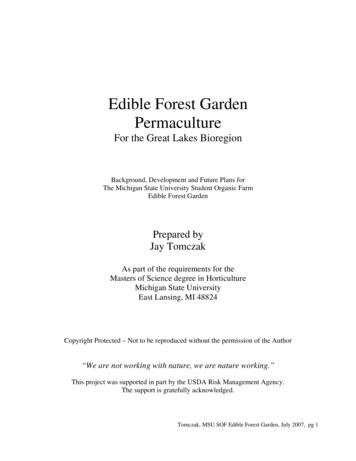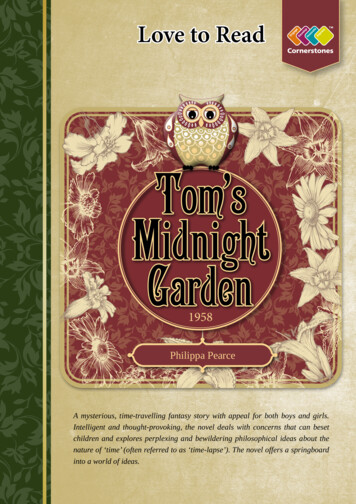
Transcription
Love to ReadTom’sMidnightGarden1958Philippa PearceA mysterious, time-travelling fantasy story with appeal for both boys and girls.Intelligent and thought-provoking, the novel deals with concerns that can besetchildren and explores perplexing and bewildering philosophical ideas about thenature of ‘time’ (often referred to as ‘time-lapse’). The novel offers a springboardinto a world of ideas.
CONTENTSOverview for teachersPageContext . . 3 About the author What’s the story about? Themes to look out forLiterary techniques. . 4–8Characters TomHatty/Mrs BartholomewThe KitsonsThe MelbournesThe AuntAbelSetting The house The garden Beyond the gardenStructureNarrative techniquesLanguageSpecial feature PersonificationActivities for children. 10–11Ideas for getting started – Engaging with the world of the noveltBefore readingt Changing landscapesDebatePictures and objectsAbout the AuthorDuring reading . 12–17Stopping places – Developing understanding of narrative and literary techniquest1234567End of Chapter IIIEnd of Chapter VIEnd of Chapter XEnd of Chapter XIIEnd of Chapter XVIIIEnd of Chapter XXIIIThe end of the novelAfter reading . . 18–19Create and imagine – Developing a personal response to the novel Magical gardenOlder and wiserGetting personalTime travellers
Every night he was able to steal downstairsas usual, into the garden; and there thefeverishness of his chill always left him,as though the very greenness of trees andplants and grass cooled his blood.
Overviewforteachers
ContextAbout the authorBorn in 1920, growing up in Cambridgeshire, Philippa Pearce was the first generation in her family togo to higher education, even though she didn’t start school until she was eight years old because of illhealth. After leaving university, she worked as an editor as well as a writer. She wrote over 30 novelsincluding ‘Tom’s Midnight Garden’, written in 1958 and winner of the Carnegie Medal in Literature thefollowing year. The novel incorporates ideas of time put forward by J. W. Dunne in his influential workAn Experiment with Time (1927).She tragically lost her husband, a former Japanese prisoner of war, after only two years of marriage.They had a daughter together who grew up to become an editor herself. Pearce died of a stroke in 2006.What’s the story about?Set during the school summer holidays in the 1950s, Tom Long is sent to stay with his Aunt Gwen andUncle Alan who live in a cramped flat in a converted old house without a garden, while his brother,Peter, recovers from measles. His aunt and uncle, although well meaning, have little idea how to relateto or entertain a young boy. Tom, during his period of quarantine, is bored, lonely and resentful, somuch so that he cannot sleep at night.One restless night he hears the grandfather clock strangely strike thirteen, so he decides to investigate.Opening the back door of the house, he enters a beautiful, sunlit garden instead of the cluttered and uglyback yard. The magical midnight garden becomes his playground, his release from the stifling realitiesof the daytime. There is something strange and unnerving about the garden though. People cannot seehim; he cannot grab things; he walks through doors - it is like he is a ghost in another reality. It is onlyHatty, another lonely child, who is capable of seeing him and together they form a firm friendship.Tom begins to realise that the midnight garden, and Hatty, are from the Victorian age, a different timeperiod to his own. It also becomes apparent that Tom’s measure of time is different to the time periodin the garden. Tom might be gone one day, but when he returns the next night, months and years havefled by in the garden and Hatty is changed as she grows up and becomes a young woman.Tom becomes increasingly attached to the garden and to Hatty and feels that he would like to spendeternity in the garden with her, instead of returning home to his family. However, he becomes ‘thinner’to her, less important in her life as she grows up and meets others, including her future husband. It is atthis point where the garden is no longer accessible to Tom and he screams at the loss.The screaming wakes up all the tenants, including old Mrs. Bartholomew who owns the house. Sheasks to meet Tom and it transpires that she is Hatty and the garden was a projection of her dreams - adreamtime, a place in time where she relived her life; a place in time that Tom entered and sharedthrough his own dreamtime: both of them longing for a different time to the present.The old woman and the young boy share a warm and loving hug of friendship that transcends thebarriers of age. Tom leaves for home a better, more mature boy than when he arrived.Themes to look out for Concepts of time Feelings of isolation Change3
Literary techniquesPresentation of character isachieved through What the character saysWhat the character doesWhat other characters say about themHow other characters react to themHow they are described in the narrativeCharactersTomAt the beginning of the story, Tom is an imperfect hero shown in an unflattering light as immature,spoilt, bitter and resentful. He is unhappy at being ‘exiled’ to his boring aunt and uncle’s place andshows his disdain towards them. As the story develops, Tom’s attitude changes, becoming less selfishand more compassionate and understanding. This is a direct result of his relationship with Hatty - shebrings out the best in him. He shows compassion towards her, is willing to go along with her fantasticalstories so as not to hurt her feelings and is genuinely horrified and worried when she falls from the treebough. When Tom’s time-travelling journey ends, finally meeting Hatty, now Mrs. Bartholomew, in thepresent time, he is ‘without bitterness’ highlighting his new, emotional maturity. He is finally ready togo home.Tom is a device to explore the ideas of time, how it does not stand still even though we may wish it to.Everything changes, for better or worse - and we have to learn to cope with it.Hatty/ Mrs BartholomewHatty is presented as a child who needs protecting and is deserving of compassion: she is an orphan,distraught and lonely, living in a big house with unsympathetic, resentful relatives - except for one. Sheis often described as ‘young’, ‘little’, ‘lonely’ and ‘forlorn’ to emphasise her weakness and vulnerability.However, according to her aunt she is ‘a liar, a criminal and a monster’.She is incredibly imaginative, telling tales - as children do - of how things came to be. In the beginningshe and Tom have a lot in common and are one another’s salvation. She is always joyful to see Tom,even as a grown woman, but eventually he becomes less important to her.Notice how, in the meantime, Pearce portrays Mrs. Bartholomew as someone to be feared, with a dislikeof children and her ‘black eyes’ suggest she is not human. Pearce is lulling the reader into a false senseof security so that the discovery at the end of the novel, that she is Hatty, has more impact.Hatty is a device to show how time moves on, people and things change; ‘Nothing stands still except inour memory,’ states Hatty/the old Mrs. Bartholomew.4
The KitsonsAunt Gwen and Uncle Alan are benign figures; well-meaning, but boring. They provide a spur forTom’s restlessness and ventures into the garden. Not only do they act as a foil to Tom’s enjoyable andmagical time when in the garden, but also present opportunities for Tom to discuss ideas he is grapplingwith - and for the reader to get another point of view on these ideas. For example, Tom and Uncle Alandiscuss the complex idea of ‘What is time?’ near the end of the novel. Uncle Alan provides Tom, andthe reader, with some scientific theories - which Pearce explores in her novel.The MelbournesThe Cousins: Hubert, James and Edgar are one-dimensional, stock characters. Hubert is older thanthe rest so is discounted and rarely appears; James is compassionate and sympathetic towards Hattywhereas Edgar is quite the opposite. They highlight Hatty’s isolation - they are all boys and enjoyplaying together. Their fun is contrasted against Hatty’s wish for fun.The AuntAgain, a one-dimensional, unsympathetic figure designed to show Hatty’s pitiful life as a child. Pearceuses the aunt and Edgar as a device to create tension in the novel. The reader soon realises that wheneverthey appear, trouble for Hatty will ensue.AbelAbel’s inclusion in the novel is perplexing and worthy of discussion. In the beginning he fulfills therole of a sympathetic character to Hatty, creating an oasis of care in a setting where there is very little.A religious man, he pretends not to see Tom to begin with, but then calls him a devil and tells him to‘Get you back to Hell’. Later, this changes and Abel smiles and winks at him. Apart from Hatty, he isthe only other person able to see Tom and the reason for this is never explained.5
SettingThe setting can Be a backdrop to the actionReflect characters’ experiencesSymbolise ideas the author wishes to conveyHave its own culture and valuesCause conflict and distressEach of the settings exist in the1890s and 1950s.The houseTom is confined to the house, quarantined as a result of his brother’s measles. Within the house there isfurther confinement imposed upon him by his aunt and uncle when he is sent to bed for ten hours. Beingconfined acts as a spur for Tom to seek adventures and provides a contrast to the magical liberation ofthe garden, enabling him to relate to Hatty’s confinement and sense of loneliness.The house also symbolises the idea of the passage of time and the changes that occur over time. Onlysmall shreds of evidence of its former glory exist: the grandfather clock and the bars on the window.Everything else has gone, built on or modified to such an extent that it is barely recognisable. Theauthor acknowledges that time does not stand still and changes will occur, but they are not always forthe best. The personification of the house acts to create a sense of unease and mystery. It reflects the lifeit has held, and still holds, within its walls.The gardenA liberating enchantment for Tom, but a childhood prison for Hatty. She is not allowed to go outsideor to climb on the wall to peek at the outside world. However, in her desire to escape the confines shetunnels through hedges that lead to a beautiful, idyllic and unspoilt meadow and river. Pearce describesthe garden in wonderful detail, naming many plants. Using a huge amount of concrete nouns rather thanabstract nouns lends the garden a reality that it doesn’t actually have. In the 1950s world the gardendoes not exist, except for a yew tree, and is an alley cluttered with rubbish bins.Beyond the gardenAs the characters get older more of the outside world is revealed. First of all they peek at it from a walland from a tree, then they wander down to the meadow and river and finally they leave the garden andskate down the river, leading to the sea - a symbol of freedom - and visit Ely Cathedral. This is a worldwhere dangers are hinted at, but never come to fruition. Once they leave the garden, it is no longeraccessible to Tom. Symbolically, leaving the garden means leaving their childhood and any protectionand predictability that may come with it. In the modern 1958 setting, it is much changed - sadly polluted- revisiting the theme of change over time.6
StructureStructure is the order or pattern in which a novelis put together and should Maintain the interest of the readerMove the action from one episode to the nextArouse a reader’s interest in character or situationCreate a moment of crisisCreate expectation or surprisePearce creates tension in the novel by hinting at a danger that never materialises, including overheardconversations and noises to enhance the idea of mystery and unease; the appearance of Edgar andHatty’s aunt signals a conflict ahead. To move the plot along, Pearce uses Tom’s letters to Peter todescribe what has gone on in the story and also act as a link to his former home.Narrative techniquesWritten in the third person narrative, the author adopts an omniscient (all-knowing) position, presentingall the action and thoughts of each character to the reader, so that the reader sees things from a differentperspective. Narrative sympathy for Tom changes in the novel as he matures and as Hatty grows up,seemingly leaving him behind.LanguageRather than introduce the garden in terms of how Tom or Hatty feel about it, the author uses concretenouns to describe it; there are hyacinths, wallflowers, pots of geraniums, heavy red poppies and lotsmore, ensuring that the garden appears real to both Tom and the reader.As ‘Tom’s Midnight Garden’ is a supernatural novel, creating the right atmosphere is important to makethe reader feel they are in a strange world. Pearce uses many words and phrases that create a sense ofmystery, unease and danger. In Chapter XXIV, a character is introduced with the words ‘dark shape’,‘it’, ‘unnaturally tall’ and ‘the figure’. She deliberately withholds information to keep the reader insuspense. She also uses many verbs to suggest that Tom or Hatty may be ghosts - Tom ‘glided’ and‘slid’ about the house and Hatty ‘haunted the room for Tom,’ adding to the eerie quality of the novel.Once again, creating a sense of mystery is a priority for the writer and another way Pearce does this isby using ellipses to suggest the illusion of the unfinished or unexplained - ‘his bare foot tried to tell himsomething.’.Pearce tantalises the reader further in her use of colons revealing or explaining some of the mystery, butonly some. For example, in Chapter V, ‘Tom stopped abruptly. On the grey-green of the dewed grasswere two clearly defined patches of darker green: footprints.’ So, while it is revealed that the patcheswere footprints, the reader is still unsure whose footprints they are.Pearce uses rhetorical questions to show Tom’s bafflement at the situation he is in. It also anticipates thereader’s own bewilderment. After Tom hears the clock strike thirteen he announces, ‘Thirteen? Tom’smind gave a jerk: had it really struck thirteen?’ (Chapter II).7
Special featurePersonificationPersonification is an example of imagery.Writers use personification to create mystery,curiosity and unease. It is a techniquewhereby an inanimate, non-human objectis given human characteristics for example,‘The traffic light blinked red’.The use of personification in Chapter II and III, when Pearce describes the house, makes it appearpowerful, supernatural and slightly menacing. It feels as though it has a soul of its own, making thereader nervous about what might happen there. The grandfather clock is also personified suggestingthat it has been alive and watching the events in the house over time. ‘But it just can’t be true,’ said Tom aloud.The house, which appeared to be following the argument, sighedimpatiently. ‘At least, I think it isn’t true; and anyway it’s muddling.’Meanwhile you’re missing your chance, whispered the house.‘I can’t honourably take it,’ said Tom, ‘because I don’t believe thegrandfather clock was telling the truth when it struck thirteen.’Oh, said the house coldly, so it’s a liar, is it? (Chapter II) Hurry! Hurry! The house seemed to whisper round him. The hour ispassing passing (Chapter III) And the only light was the moonbeam that glanced sideways through thestairway window and spent itself at once and uselessly on the wall by thewindow-sill. (Chapter III)8
Activitiesforchildren
Before readingIdeas for getting startedEngaging with the world of the novelChanging landscapesFind out how your area has changed since 1890 and 1958.Take photographs to show what has been built. What has beendemolished? What has disappeared? How have the peoplechanged? What jobs did they once do? What brought aboutchange? Which era do you prefer?DebateWhat is time? How important is it?Is time-travel possible?Why do fashions in clothes change?How does fashion reflect a society?Which era in history would you like to time-travelto most and why?Do you believe in ghosts?10
Pictures and objectsLook at a range of pictures of grandfather clocks. Think of adjectives to describethem. Which one is the most intimidating and why?Use the Internet and other visual and historical resources to find out aboutVictorian gardens. Why did Victorians consider their gardens to be so important?What types of plants did they grow? How would the Victorian garden be differentfrom a contemporary, average family garden?Find pictures of houses from both the Victorian age and the 1950s. How were theydifferent? Consider which you would prefer to live in and why.About the authorWho was Philippa Pearce?What facts can you find out about her?Which other significant authors were writing novels during the1950s? Which other classic children’s books were writtenduring this period?11
During readingStopping places1Developing understanding of narrative and literary techniquesRead to the end of Chapter IIIBy MoonlightFocus on. First impressions of the novel andits characters The importance of settingThings to discussCharacter: Which characters are you introduced to and what do you learnabout them? Do your sympathies for the characters change at all in the firstthree chapters? Do you like Tom? How do you think you are meant to feelabout him?Setting: What do you learn about the setting? In what way do you think thegarden is going to be important? In what way do you think the change in thehouse is going to be important?What questions do you want answering?What seems strange to you? How do the irregularities and oddities makeyou feel?What are your thoughts about the significance of the grandfather clock?Why might it be locked? Why strike thirteen?How do you explain the change in the house?Are the events in the house really happening or is it all in Tom’s head?How does the house make you feel?Tone: Pearce creates a sense of mystery in Chapter III. How does she beginto do this?‘psst.’She uses ellipses to suggest the idea of things being unfinished orunexplained. She also uses questions to highlight the idea of perplexity.Tom reacts ‘dumbfounded’ to events; the items disappearing cannot beexplained, there is a door he had never seen opened and the house ispersonified, which is highly unusual.Story: What do you think the novel is going to be about?What do you expect to happen next?12
2Read to the end of Chapter VIThrough a DoorFocus on. The presentation of the garden The tone of the novelThings to discussCharacter: In your opinion, which of the following characters in these three chapters is going to be mostimportant: Mrs Bartholomew, the man with the ginger beard or the gardener? Why?Setting: Why do you think the garden is described in so much specific detail?Tone: How does Pearce create a sense of unease in the last few chapters? Why do you think things havestopped being perfect? Is Tom being watched? What is the effect of changing the setting to night-time in thegarden and including a vicious storm? How do these add to the vulnerability felt by Tom and the reader?What is the effect of using verb phrases like ‘deathly chilling’ and ‘struggling wildly’?You could.3.work in groups to write down any unanswered questions so far. Discuss what the answers might be andhow Pearce has managed to prompt these questions through her literary techniques.Read to the end of Chapter XGames and TalesFocus on. Introduction of new characters How a sense of mystery is createdThings to discussCharacter: What are your first impressions of the three boys: Hubert, James and Edgar? What words areassociated with Edgar and what words with James? What does that tell you about the characters?Which boy would you prefer to be friends with? Which boy interests you most? Why?What do you expect to happen when Edgar appears in the novel?Pearce establishes Edgar as someone to be disliked, who causes trouble, so that hisappearance is a device to cause upset and tension within the novel.‘psst.’What do you think of Hatty? How far do you trust Hatty? Do you believe her stories?How would you describe Tom and Hatty’s relationship so far? What questions would you like answeringabout Hatty?Tone: What mysteries have been solved and which still exist? How does this make you feel? Are you gladto have some of the mysteries explained or frustrated that some still exist?You could.Go through the novel so far to find evidence of how Pearce creates mystery. For example, in Chapter VI,she uses indistinct descriptions like ‘someone’, ‘figure’ and ‘it’ when introducing a new character to thereader. Pick out some examples of your own and explain how you think mystery is created for the reader.13
4Read to the end of Chapter XIIThe GeeseFocus on. The presentation of Hatty The change in toneThings to discussCharacter: How is Harriet’s aunt presented? What does she say, do? How doothers react to her? What’s your opinion of Hatty’s aunt?Characters have previously referred to Hatty’s aunt in unflattering terms, butthis is the first time the reader meets her.Is she what you expected? How did you feel at the thought of meeting her?‘psst.’The author creates a sense of dreaded anticipation within the reader byreferring to Hatty’s aunt rather than introducing her straight away.Structure and Tone: How do you feel after reading the last chapter?How does it compare with the mood portrayed at the beginning of ChapterXI, The River to the Sea?Why do you think Pearce put a playful chapter before a chapter of chaos andwoe? Were you expecting such a change in mood? What made you feel theway you do?Pearce uses contrast to emphasise the pity the reader feels for Hatty.‘psst.’What type of story do you think you are now going to read? What do youthink will happen to the mood of the story now?You could.Create a relationship diagram with Tom at the centre and the other characterssurrounding him showing how close they are to him, or not. Discuss ideaswith others in the class.14
5Read to the end of Chapter XVIIIThe Bedroom with the TwoBarred WindowsFocus on. A different view of Tom The change in time in ‘Hatty’s World’Things to discussCharacter: Who do you think is the ghost, Hatty, Tom or both? Why?Why can Abel also see Tom? Abel thinks Tom has come from hell, amischievous spirit intent on killing Hatty. What do you think? Why arewe given this other perspective of Tom? How does it affect your feelingsabout Tom?‘psst.’Pearce’s prime motive is to create mystery and doubt as to Tom’s truenature and role in the novel. The reader is uncertain as to whether Tomis a ghost, a devilish time-travelling spirit or a boy in a magical dream.Structure: Why do you think time has fast-forwarded in the novel? Howdoes it make you feel?‘psst.’Pearce continues to create mystery and a sense of bewilderment byshifting time forward. It adds to the supernatural feeling of the novel.It also acts as a device to show the change in relationship between Hattyand Tom.What do you think will happen next? How will their relationship develop?Why is Hatty’s timescale different to Tom’s?Why does Pearce let the reader, through Tom, witness the conversationbetween James and his mother about Hatty, but not the conversationbetween James and Hatty?Describe your feelings for each of the characters now.Symbolism: The grandfather clock is a recurring symbol in the novel.What do you associate with it whenever it appears?You could.Pick out words and phrases that show the theme of being trapped. Who,in your opinion, is more trapped by their surroundings: Tom or Hatty?15
6Read to the end of Chapter XXIIISkatingFocus on. Ideas about timeThings to discussTheme: In Chapter XX, Tom and Hatty discover some mysterious letteringengraved on to the pendulum of the grandfather clock stating ‘Time NoLonger’. Using Abel’s bible they trace the quotation and find it is taken fromthe Book of Revelations. Skim read Chapter XX to find the biblical passagewhich ends in the words ‘time no longer’. Re-read the section and think aboutwhat the words ‘time no longer’ mean to you.Compare this quotation to the passage in Chapter XXIII when Tom notices thewords ‘Exchanged Time for Eternity’ on a memorial tablet at Ely Cathedral.What do the words ‘exchanged time for eternity’ mean to you?How do you think the two quotations relate to each other? What messageabout time do they give?How is danger presented at the end of the ‘Skating’ chapter?What do you think will happen next?You could.Collect words and phrases from the later part of the novel to do with time andwork out what ideas about time are being presented by the author.16
7Read to the end of the novelFocus on. How the novel ends Your response to the novel as awholeThings to discussThe Story: What did you think about the ending? Was it the right ending foryou or would you have written it differently?What clues did the author use to help you predict what was going to happenlater in the novel?Explain what your first reaction was after reading the novel. Why do youthink that was?Do you still have questions that you want answering? What makes youcurious in this novel?What is the most important part of the novel?Character: How did Hatty and Tom’s relationship develop? Did it surpriseyou in any way?Do Tom’s relationships with other characters change? How? Are you satisfiedwith the changes or lack of change? Which characters did you like or dislike?Why do you think Pearce described Hatty in flattering terms and Mrs.Bartholomew in unflattering, fearful terms when they are the same person?What might each character symbolise?Who was the most interesting character? What do you think Tom has learntin the novel? What have you learnt?The Setting: How would you describe the two worlds in the novel? How dothey compare and contrast?Which world would you prefer to be in? How does the garden reflect Hattyand Tom’s experiences?Why does it confine one and act as a sense of liberation for the other? Whatmight it symbolise?You could.Start to think about your personal response to the novel by choosing one ofthe activities in the Create and Imagine section.17
After readingCreate & imagineDeveloping a personal response to the novelMagical gardenDraw a range of flowers from close observation usingwatercolour paints to create ‘classic’ botanical paintings.Use a wire frame to create an enlarged flower head. Cover withtissue paper using PVA glue to create a wonderful 3D sculpture.Display as a ‘class garden’.Use digital cameras to take photographs of gardens and othernatural outdoor settings. Think about ways of adding interest bylooking from unusual viewpoints. Upload images to a computerand manipulate using a photo-manipulation package toexperiment with tones, size and perspective.Create a written, audio orvideo document of yourinterviewOlder and wiserInterview someone older than you to find out what it was like for them as achild. What music did they listen to? What did they wear? What were theylike at school? What were their friends like? Did they enjoy being a child?How does being a child compare to being an adult?If they could impart one piece of advice to a child,what would it be?18
Getting personalChoose a favourite object and write examples ofpersonification you might use to describe it. Use theseexamples and phrases to build a poem about your objectusing personification to highlight its mystery, power,strangeness or ‘character’. Learn your poem by heart andrecite it to an audience.Time travellersPrepare questions to hot-seat one or more of the characters from thenovel. Find out what they thought about each other and the strangeevents within the story.Improvise or script a scene which explores the notion of time travel.Which historical period would you like to travel to? Imagine Tom orHatty visiting your world. What differences would they notice? Howwould they react?Use physical theatre to create a scene in which the grandfather clock,barometer, umbrella stand or other items of furniture reveal what theyhave seen in their time in the house. Share work with an audience.19
Memorable quotesThe stillness had become an expectant one; the house seemed tohold its breath; the darkness pressed up to him, pressing him with aquestion: Come on, Tom, the clock has struck thirteen – what are yougoing to do about it?Hurry! hurry! the house seemed to whisper round him. The hour ispassing.passing There is a time, between night and day, when landscapes sleep. Onlythe earliest riser sees that hour; or the all-night traveller, letting upthe blind of his railway-carriage window, will look out on a rushinglandscape Fear made him hurry now; yet, even so, he paused on the thresholdof the house and turned back to look at the footprints on the grass:they were still plainly visible although the warmth of the rising sunwas beginning to blur their edges. (It did not strike him as odd that hisown footsteps, which had crossed the lawn again and again, had leftno similar trace).Visibility invisibility.If he were invisible to the people of the garden,he was not completely so at least to some of the other creatures. Howtruly they saw him he could not say; but birds cocked their heads athim, and flew away when he approached.
Hatty had said wistfully that Hubert and James and Edgar used toplay at forest outlaws, with bows and arrows made in the garden.‘Why didn’t you?’ asked Tom.‘ They said I was too young; and, then, when I was old enough, theysaid they were too old.’Suddenly Tom said – he blurted it out before he could help himself:‘What’s it like – I
him; he cannot grab things; he walks through doors - it is like he is a ghost in another reality. It is only Hatty, another lonely child, who is capable of seeing him and together they form a firm friendship. Tom begins to realise that the midnight garden, and Hatty, are fr

